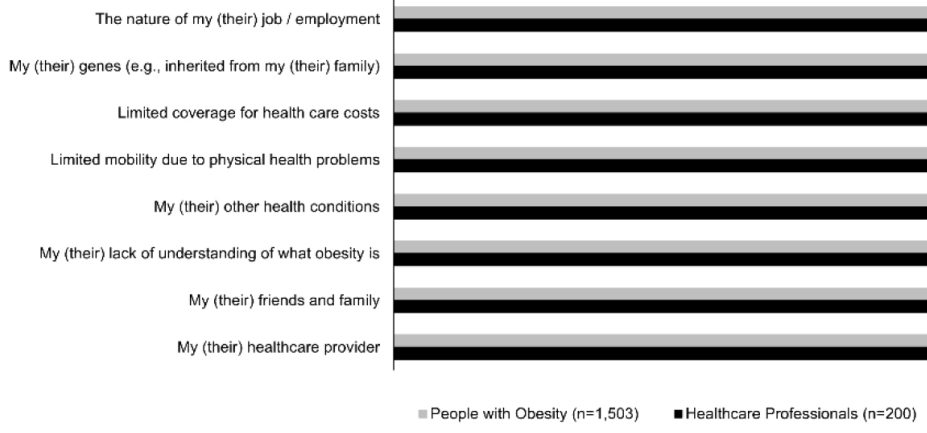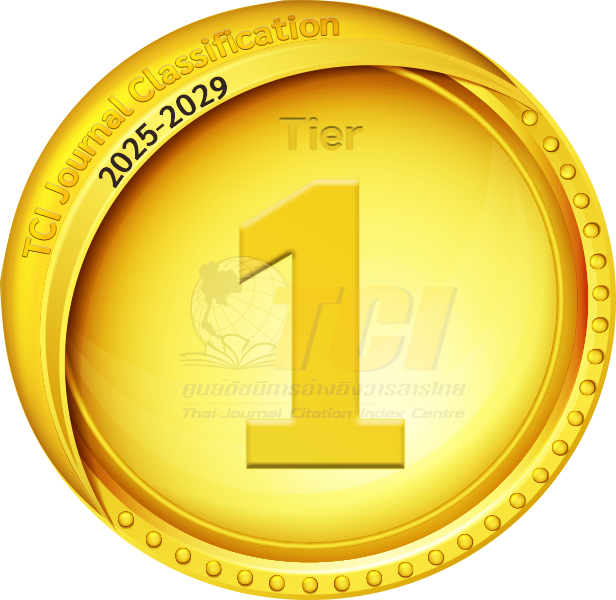PERCEPTIONS, ATTITUDES, BEHAVIORS, AND BARRIERS OF PEOPLE WITH OBESITY AND HEALTH CARE PROFESSIONALS ABOUT OBESITY AND ITS MANAGEMENT: THAILAND PERSPECTIVE FROM THE ACTION APAC SURVEY STUDY
DOI:
https://doi.org/10.55374/jseamed.v9.229Keywords:
ACTION APAC, Thailand, attitudes, barriers, obesity, awareness, weight stigma, people with obesityAbstract
Background: Obesity rates are increasing in Thailand, with their impact extending beyond the healthcare system, conferring a substantial burden on the individual, society, and the economy.
Objectives: The ACTION APAC (Awareness, Care and Treatment In Obesity Management Asia Pacific) study aimed to identify perceptions and attitudes towards obesity among people with obesity (PwO) and healthcare professionals (HCPs) in the Asia Pacific (APAC) region. Here, we report the findings of the Thailand data set.
Methods: An online, cross-sectional survey was conducted across nine countries, including Thailand, recruiting respondents (PwO, HCPs) through online, telephone, and public intercept methods. PwO participants aged 18 years and older (body mass index ≥25 kg/m²) were included based on self-reported height and weight. Eligible HCPs had over two years of direct patient care experience. Data were analyzed using descriptive statistics.
Results: In total, 1,503 PwO and 200 HCPs completed the survey. Most PwO (74%) and HCPs (92%) recognize obesity as a chronic disease; however, only 49% of PwO discussed weight with their HCP, and 51% felt weight loss was their responsibility. The primary reasons for not discussing weight included self-responsibility (PwO, 34%) and HCPs perceiving the patient as uninterested (39%). Most PwO (78%) liked HCPs discussing weight, with only 11% feeling offended. While 48% of PwO relied on the Internet for weight management information, only 28% consulted HCPs. PwO and HCPs identified a lack of exercise and unhealthy eating habits as significant barriers to weight loss and preferred a healthy diet and exercise to lose weight.
Conclusions: Recognizing that most Thai PwO appreciate HCPs initiating weight discussions presents an opportunity for proactive, open, and collaborative dialogue by HCPs. Further, there is a nationwide need to improve awareness about obesity and obesity-specific interventions to improve its management.
Downloads
Metrics
References
Wharton S, Lau DCW, Vallis M, Sharma AM, Biertho L, Campbell-Scherer D, et al. Obesity in adults: a clinical practice guideline. Can Med Assoc J 2020; 192: E875-E91.
Nicolaidis S. Environment and obesity. Metab 2019;100:153942.
Masood B, Moorthy M. Causes of obesity: a review. Clin Med 2023; 23: 284-91.
Sakboonyarat B, Pornpongsawad C, Sangkool T, Phanmanas C, Kesonphaet N, Tangthongtawi N, et al. Trends, prevalence and associated factors of obesity among adults in a rural community in Thailand: serial cross-sectional surveys, 2012 and 2018. BMC Public Health 2020; 20: 850.
Limpawattana P, Panitchote A, Tangvoraphonkchai K, Suebsoh N, Eamma W, Chanthonglarng B, et al. Delirium in critical care: a study of incidence, prevalence, and associated factors in the tertiary care hospital of older Thai adults. Aging Ment Health 2016; 20: 74-80.
Thailand faces rising obesity rates, experts call for systemic change. The Nation. 2025 [updated 04 March 2025. Available from: https://www.nationthailand.com/health-wellness/40047013.
Thailand’s leadership in the fight against obesity World Health Organization 2025 [updated 07 March 2025. Available from: https:// www.who.int/thailand/news/feature-stories/ detail/thailand-s-leadership-in-the-fightagainst-obesity
Jitnarin N, Kosulwat V, Rojroongwasinkul N, Boonpraderm A, Haddock CK, Poston WSC. Risk factors for overweight and obesity among Thai adults: Results of the National Thai Food Consumption Survey. Nutrients 2010; 2: 60-74.
Obesity W. Thailand policies, interventions and actions [Internet]. 2020. Available from: https://data.worldobesity.org/country/thailand-214/actions.pdf
Tham KW, Abdul Ghani R, Cua SC, Deerochanawong C, Fojas M, Hocking S, et al. Obesity in South and Southeast Asia-A new consensus on care and management. Obes Rev 2023; 24: e13520-e.
Techagumpuch A, Pantanakul S, Chansaenroj P, Boonyagard N, Wittayapairoch J, Poonthananiwatkul T, et al. Thai Society for Metabolic and Bariatric Surgery Consensus Guideline on bariatric surgery for the treatment of obese patients in Thailand. J Med Assoc Thai 2020; 103: 300-7.
Tham KW, Ahmed A, Boonyavarakul A, Garcia MM, Guajardo M, Hanipah ZN, et al. ACTION APAC: Understanding perceptions, attitudes and behaviours in obesity and its management across South and Southeast Asia.n/a(n/a): e12644.
Public Policy Committee ISoP. Guidelines for good pharmacoepidemiology practice (GPP). Pharmacoepidemiol Drug Saf 2016; 25: 2-10.
Appropriate body-mass index for Asian populations and its implications for policy and intervention strategies. Lancet (London, England) 2004; 363: 157-63.
Lim S, Oh B, Lee SH, Kim YH, Ha Y, Kang JH. Perceptions, attitudes, behaviors, and barriers to effective obesity care in South Korea: Results from the ACTION-IO Study. J Obes Metab Syndr 2020; 29: 133-42.
Grannell A, Fallon F, Pournaras D, le Roux CW. Exploring patient beliefs and perceptions regarding obesity as a disease, obesity causation and treatment. Ir J Med Sci 2021; 190: 163-8.
Jensen MD, Ryan DH, Apovian CM, Ard JD, Comuzzie AG, Donato KA, et al. 2013 AHA/ ACC/TOS guideline for the management of overweight and obesity in adults: a report of the American College of Cardiology/American Heart Association Task Force on Practice Guidelines and The Obesity Society. Circulation 2014; 129: S102-S38.
Elmaleh-Sachs A, Schwartz JL, Bramante CT, Nicklas JM, Gudzune KA, Jay M. Obesity management in adults: A review. J Am Med Assoc 2023; 330:2000-15.
Ochner CN, Barrios DM, Lee CD, Pi-Sunyer FX. Biological mechanisms that promote weight regain following weight loss in obese humans. Physiol Behav 2013; 120: 106-13.
Elfhag K, Rössner S. Who succeeds in maintaining weight loss? A conceptual review of factors associated with weight loss maintenance and weight regain. Obesity reviews.
Sarwer DB, von Sydow Green A, Vetter ML, Wadden TA. Behavior therapy for obesity: where are we now? Curr Opin Endocrinol Diabetes Obes 2009; 16: 347-52.
Moorman EL, Warnick JL, Acharya R, Janicke DM. The use of internet sources for nutritional information is linked to weight perception and disordered eating in young adolescents. Appetite 2020; 154: 104782.
Tonsaker T, Law S, Ormel I, Nease C, Bartlett G. Engaging caregivers: exploring perspectives on web-based health information. Fam Pract 2016: cmw084.
Gunther S, Guo F, Sinfield P, Rogers S, Baker R. Barriers and enablers to managing obesity in general practice: A practical approach for use in implementation activities. Qual Prim Care 2012; 20: 93-103.
Bays HE, Golden A, Tondt J. Thirty Obesity Myths, Misunderstandings, and/or Oversimplifications: An Obesity Medicine Association (OMA) Clinical Practice Statement (CPS) 2022. Obesity Pillars 2022; 3: 100034.
Jackson SE, Wardle J, Johnson F, Finer N, Beeken RJ. The impact of a health professional recommendation on weight loss attempts in overweight and obese British adults: a cross-sectional analysis. BMJ Open 2013; 3: e003693.
Kahan SI. Practical strategies for engaging individuals with obesity in primary care. Mayo Clin Proc 2018; 93: 351-9.
Durso LE, Latner JD. Understanding self‐ directed stigma: development of the weight bias internalization scale. Obesity 2008; 16
Lillis J, Luoma JB, Levin ME, Hayes SC. Measuring weight self‐stigma: the weight self‐stigma questionnaire. Obesity 2010; 18: 971-6.
Lin C-Y, Tsang HWH. Stigma, health and well-being. Int J Environ Res Public Health 2020; 17: 7615.
Puhl RM, Heuer CA. Obesity stigma: important considerations for public health. Am J Public Health 2010; 100: 1019-28.
Ginsburg BM, Sheer AJ. Destigmatizing obesity and overcoming inherent barriers to obtain improved patient engagement [Internet]. Treasure Island (FL): StatPearls Publishing; 2024. Available from: https://www.ncbi.nlm. nih.gov/books/NBK560733/
Tham KW, Ahmed A, Boonyavarakul A, Garcia MM, Guajardo M, Hanipah ZN, et al. Action APAC: understanding perceptions, attitudes and behaviours in obesity and its management across South and Southeast Asia. Clin Obes 2024; 14: e12644.
Iwabu M, Yamauchi T, Shimomura I, Eguchi K, Ogawa Y. Perceptions, attitudes and barriers to obesity management: Japanese data from the ACTION-IO study. J Diabetes Investig 2021; 12: 845-58.
Caterson ID, Alfadda AA, Auerbach P, Coutinho W, Cuevas A, Dicker D, et al. Gaps to bridge: Misalignment between perception, reality and actions in obesity. Diabetes Obes Metab 2019; 21: 1914-24.
Yanovski SZ, Yanovski JA. Long-term drug treatment for obesity: A systematic and clinical review. J Am Med Assoc 2014; 311: 74-86.
Khera AV, Emdin CA, Drake I, Natarajan P, Bick AG, Cook NR, et al. Genetic risk, adherence to a healthy lifestyle, and coronary disease. N Engl J Med 2016; 375: 2349-58. Int J Obs 2005; 6: 67-85.

Downloads
Published
How to Cite
Issue
Section
License
Copyright (c) 2025 Journal of Southeast Asian Medical Research

This work is licensed under a Creative Commons Attribution-NonCommercial-NoDerivatives 4.0 International License.
The Journal of Southeast Asian Medical Research will hold the copyright to all published articles. The publisher's production department handles copyright forms once a manuscript is accepted and scheduled for publication.







